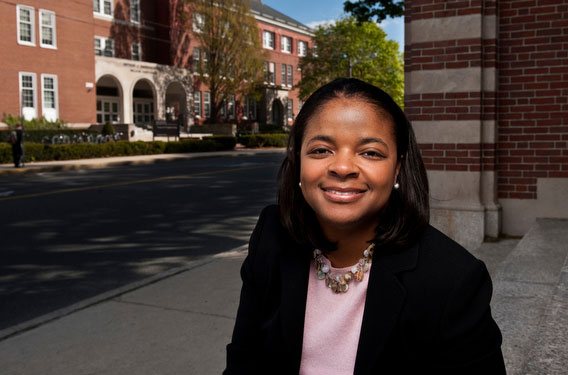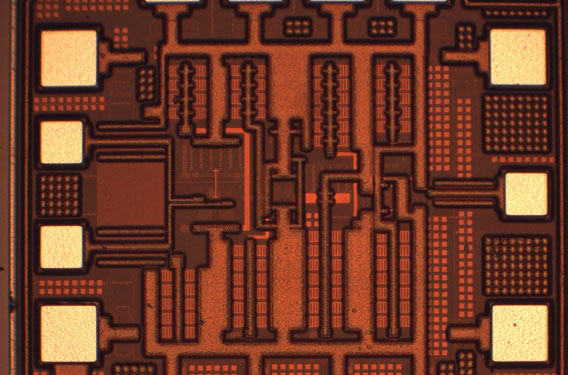Changing the Face of Engineering
Valencia Joyner has taken her place on technology’s cutting edge, and now she’s determined to help other women and minorities do the same
By Chris Berdik
In 1993, as a public high school senior in Washington, D.C., Valencia Joyner applied to MIT. Her parents had never heard of the school. Her guidance counselors advised against aiming so high. Indeed, when Joyner, an African American, was accepted, she became part of a student body only 30 percent female and less than 4 percent black.

Valencia Joyner recently won a prestigious 2010 National Science Foundation Early Career Development grant. Photo: Alonso Nichols
Now an assistant professor of electrical and computer engineering at Tufts and the recipient of a prestigious 2010 National Science Foundation Early Career Development grant, Joyner says she could never have beaten those odds, and might never have tried, without the help of dedicated mentors, after-school enrichment and summer science internships.
That’s why Joyner’s research—she’s an expert on imaging and communications technology and artificial intelligence—is matched by her efforts to bring more women and underrepresented minorities into the academic and professional worlds of math, science and engineering.
“It’s all about exposure,” says Joyner. Her recent NSF grant, called a CAREER award, includes funding for visits to colleges serving minority populations to talk about fellowships and graduate school applications—“all the things I didn’t know about when I started my journey to an advanced degree in engineering,” she says.
What she mostly does, of course, is her science, and one of her goals is nothing short of revolutionizing biological imaging. Current imaging technologies, used to diagnose disease or monitor health, require large machines and immobile patients. They typically lack the fine resolution, spatial range and processing speed needed to reveal some of the minute biological structures and physiological details, such as blood oxygenation or the presence and activity of proteins in the blood, that are critical for understanding, diagnosing and preventing disease.
Joyner, who directs the Advanced Integrated Circuits and Systems Lab, is focusing on optical sensors. Her goal is to develop sensor circuitry that can process multiple wavelengths of light passing through human tissue at many points simultaneously. The sensors would be wirelessly networked, and the images from them would be delivered in real time, with very fine resolution. In short, as Joyner puts it, “we want a system on a chip, with sensor, signal processing, data storage and wireless transmission.”

Valencia Joyner’s research on imaging and communications technology and artificial intelligence is matched by her efforts to bring more women and underrepresented minorities into math, science and engineering. Photo: Courtesy of Valencia Joyner
If neuroscientists had such a system, they could observe the brain activity of a patient as she performs her daily activities, instead of having to work with images taken as she lay motionlessly inside an MRI machine. The system could also be used for continuous bio-monitoring of a patient with a heart murmur or other high-risk condition.
“Anyone could wear these sensors like you wear a watch or a necklace and wirelessly provide non-invasive bio-imaging and diagnostic information,” says Sergio Fantini, a professor of biomedical engineering who is developing near-infrared imaging for mammography. In addition to sharing data, Fantini has given Joyner several “tissue phantoms,” which are small, white plastic rectangles that scatter and absorb light just as human tissue does. The devices have proven invaluable for testing the imaging technology under development in Joyner’s lab.
Sharing the Bounty
The bio-imaging endeavor would be challenge enough for the average researcher, but Joyner’s interests are much broader. Her other projects include work on a “central nervous system” for soft-bodied robots that is being funded by the Defense Advanced Research Projects Agency (DARPA). Such robots, modeled on caterpillars, could search for survivors in collapsed buildings after natural disasters or slither inside bombs and defuse them. Joyner is also involved in an initiative backed by the National Science Foundation to transform energy-efficient LED lighting into a broadband data communications system. Earlier this year, she joined researchers at Pennsylvania State University and the University of California, Riverside, to establish a Center for Optical Wireless Applications that would help develop LED data transmission in partnership with industry.
The road to bringing any of these technologies out of the lab and into reality is a long one. Indeed, the scale of that journey can be gauged by the time and effort required to complete just a couple millimeters of circuitry. Joyner’s lab team spends months using special computer software to design and simulate a chip. And when they’re satisfied, their work still is not over. They have a company like IBM fabricate the chip, which they then integrate into a circuit board for testing.
The process is not only arduous; it’s pricey. The software alone costs about $100,000 to buy and $6,000 a year to license. Then there’s the cost of the high-powered computers to run it, and the technical support to help fix the inevitable bugs. Manufacturing a single chip costs about $10,000.
Yet even as she deals with such tribulations, Joyner uses the bounty she enjoys to help others. She is well aware that many institutions serving minorities may not have access to the kind of circuit-design resources she relies on, and so she offers internships in her lab to undergraduates at these institutions.
“Companies in the semiconductor industry expect new graduates to have this experience,” says Joyner. Then she shows off her lab’s oscilloscope, which looks like a portable television and is used to test signals from the chips her team designs. Nearby is the small laser that the researchers use to test the light-processing capabilities of their bio-imaging sensor chips.
“Testing is 90 percent of the work we do here,” says Joyner. “You can design something that will give you the world, but to test it and get some good results is a different story.”
Pairing Instruction with Inspiration
In her office at the Advanced Technology Lab at 200 Boston Ave. near the Medford/Somerville campus, Joyner picks up a purple pen and draws a series of zig-zag lines, circles and triangles on a whiteboard to represent the bits and pieces of circuitry that will underlie the new class of sensors she has envisioned. It’s clear that she loves to teach, and according to her colleagues, she pairs instruction with inspiration.
“Her advisees completely look up to her,” says Lenore Cowen, a computer science professor who works with Joyner in the Computer Science, Engineering, and Mathematics Scholars Program, which supports and mentors first-generation college students in technical majors.
Joyner is also the faculty advisor for the Tufts student chapter of the National Society of Black Engineers and the Boston chair of IEEE Women in Engineering. And she’s active in a community group run through her church that helps middle school and high school students with math, science and reading.
“I think more minority students and women believe they can be engineers when they look at somebody like Valencia and see how well she’s succeeded,” says Cowen.
Chris Berdik is a freelance writer based in Boston.


